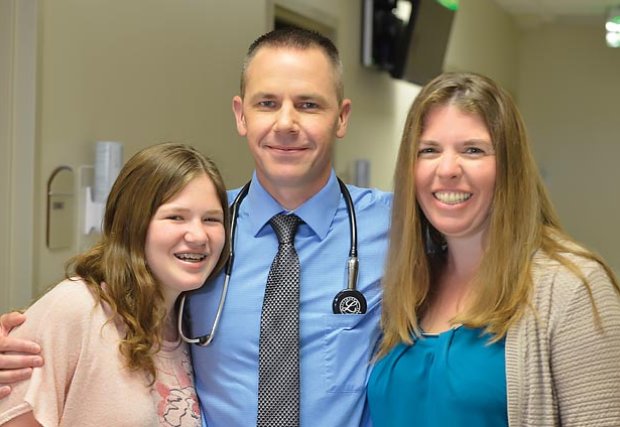Dr. Newson is back to his full and busy life with his wife, Susan, and their daughter, Brooke.
Emergency room doctor Shad Newson, MD, was getting ready for his 6 a.m. shift at Coon Memorial Hospital in Dalhart when he noticed something was wrong. “I’d gone in late the night before to check on a patient and went to sleep in an on-call room to rest before my shift,” he explains. “I woke up to get a drink of water at around 4 a.m. and started to feel some unusual sensations in my face. I looked in the mirror and I had some facial droop,” he says. His human instinct was to deny what was happening, but he recognized the symptoms of a possible stroke immediately and knew he needed to get help right away.
“Instead of walking to the door, I veered off to the right and ended up walking into the wall,” he says. He struggled down the hall to the nurses’ station where the team jumped into action. In an hour, the results of a CT scan confirmed that he had a blood clot obstructing blood flow to his brain. Next, he was looking into the eyes of a neurologist from Montana – through the screen of a telemedicine robot.
This robotic equipment is provided to Coon Memorial Hospital through Northwest’s telestroke program to give patients in the rural community access to advanced care within minutes of a possible stroke. It enables neurologists to assess patients remotely and make recommendations about treatment.
Along with his facial changes and trouble walking, Dr. Newson was also experiencing slurred speech and difficulty swallowing; but his level of consciousness was not affected, and he was able to consult with the teleneurologist. Based on his assessment, he was treated with tPA, a medication to help dissolve his blood clot. As the drug was being administered, he was transferred to Northwest in Amarillo, a Joint Commission-certified Primary Stroke Center.
Sabra McFarland, BSN, RNC-NIC, stroke coordinator at Northwest, explains that patients must be closely monitored after they receive tPA because they may be at higher risk of bleeding. Northwest can provide that specialized care in the ICU.
“Within a few hours after arriving at Northwest, my symptoms had all gone away except a little numbness on the right side of my face,” Dr. Newson says. He saw the same teleneurologist he’d seen earlier for follow-up, and he was able walk out of the hospital after 24 hours of being monitored. Within days of his emergency treatment, he was back to his routine at work and at home with his wife and their daughter.
He has since joined Northwest as an emergency room physician. This past March, about one year after his stroke, he participated in a marathon in New Mexico and came in 50th out of 1100 runners.
“You never expect it if you’re young and healthy,” says Dr. Newson, who is just 41 years old and had no indications of health problems before his stroke. Recognizing the symptoms quickly and getting rapid care saved his life. “The motto is, time matters, and it’s better to get help sooner than later,” he says.
Recognize These Signs of a Possible Stroke and Act FAST
The most common symptoms of a possible stroke can be remembered by this acronym:
FACE: Ask the person to smile. Does one side of the face droop?
ARMS: Ask the person to raise both arms. Does one arm drift downward?
SPEECH: Ask the person to repeat a simple phrase. Is it slurred or strange?
TIME: is critical! If you see any of these signs, call 9-1-1 immediately.
If these symptoms appear, DON’T WAIT! Call 9-1-1 or seek medical attention right away.

